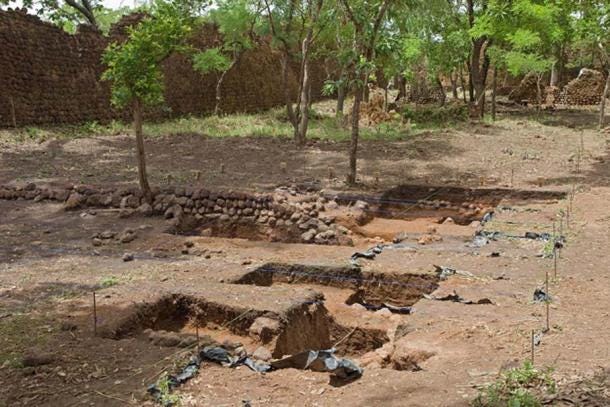Ruins of Loropeni Shed Light on Ancient Gold Trade and Are Thought to Hold More Mysteries
Loropeni is a town located in the southern part of Burkina Faso, near the country’s border with Côte d’Ivoire and Ghana. The town is known for the nearby stone ruins, which was inscribed as a World Heritage Site , Burkina Faso’s first, in 2009. Despite its incredible historical significance, the ruins have received little attention. As a result, not much is known about the site and the ruins are at risk of suffering from continual damage over time.
The ruins of Loropeni are part of the larger Lobi Ruins, a cultural landscape covering an area of 193 km by 97 km (120 miles by 60 miles). About 100 stone enclosures have been identified in the Lobi Ruins, with the ruins of Loropeni considered to be the best-preserved example of this type of fortified settlement.

In Excellent Condition but More Study Needed
The excellent state of preservation of the ruins is evident in the laterite stone perimeter wall, which is quadrangular in shape and encloses an area of 2.5 acres. In parts of the circuit, the walls reach a height of 6 m (20 feet) and have a thickness of 1.2 m (4 feet). Within the falls, however, are the remains of an abandoned settlement. As not much archaeological work has been carried out at the site, little is known about the people who once lived there.

Connected to the Trans-Saharan Gold Trade
Be that as it may, it is widely accepted that the Loropeni was connected to the Trans-Saharan gold trade that lasted from the 7 th to the 17 th centuries AD. The lands of Sub-Saharan Africa were rich in gold and this precious metal was sought after by the rulers of the states around the Mediterranean. Salt was exchanged for this gold and the trade between Sub-Saharan Africa and Mediterranean brought great wealth to those along its trade route. Consequently, the region saw the flourishing of a network of settlements as well as the rise of several powerful states during that period. The 7 th century, for instance, saw the rise of the Ghana Empire while the Mali Empire came to power during the 13 th century.

Area Settled as Early as the 11 th Century
Radio-carbon dates provided by recent archaeological excavations suggest that Loropeni was occupied as early as the 11 th century. The site was occupied by either the Lohron or Koulango peoples, who controlled the mining and transformation of gold in the region. The settlement reached its zenith between the 14 th and 17 th centuries. As a consequence of the development of shipping routes, Trans-Saharan trade began to dwindle and the settlements along these trade routes, including Loropeni, went into decline. In the early 19 th century Loropeni was abandoned for good.
Valuable Information Untapped
It is expected that archaeological work that may be carried out at the site in the future would provide valuable information about the settlement’s history and the people who lived there. Another major concern regarding the site is its preservation. Despite its excellent state of preservation, it is currently threatened by the forces of nature. The walls, being exposed, are most at risk. For instance, tropical rains and rough winds are causing erosion, weakening the structure of the walls, while the activities of burrowing animals are weakening their foundations.
Did Ancient Humans Acquire Nautical Knowledge by Sailing the Prehistoric Megalakes of Africa?
Ten Stunning Yet Little Known Ancient Treasures Across Africa
Cave Provides 78,000 Years of Cultural and Technological Evolution in East Africa

Preservation Measures Desperately Needed
The urgency of the situation has led to measures being taken to safeguard the ruins of Loropeni. As an example, the area surrounding the site has been designated as a buffer zone, to prevent agricultural encroachment as well as to protect the site from bush fires. The latter, which occurs frequently during the dry season, coupled with the rising damp during the rainy season, has caused the loss of much of the stone cover on the lower courses of the walls. A conservation plan has also been developed, which aims not only to minimize damage to the ruins but also to stimulate economic development in and around the wider Loropeni area.

Top image: The ruins of Loropeni, a market town in southern Burkina Faso, lying west of Gaoua. Source: Rita Willaert CC BY-SA 2.0
By Wu Mingren
References
African World Heritage Sites, 2018. Ruins of Loropeni - Burkina Faso. [Online]
Available at: https://www.africanworldheritagesites.org/cultural-places/ancient-sub-saharan-civilisations/ruins-of-loropeni.html
jfrank, 2018. Ruins of Loropéni. [Online]
Available at: https://www.atlasobscura.com/places/ruins-of-loropeni
The Metropolitan Museum of Art, 2000. The Trans-Saharan Gold Trade (7th–14th Century). [Online]
Available at: https://www.metmuseum.org/toah/hd/gold/hd_gold.htm
UNESCO, 2018. Ruins of Loropéni. [Online]
Available at: https://whc.unesco.org/en/list/1225
World Monuments Fund, 2018. Loropeni Ruins. [Online]
Available at: https://www.wmf.org/project/loropeni-ruins

